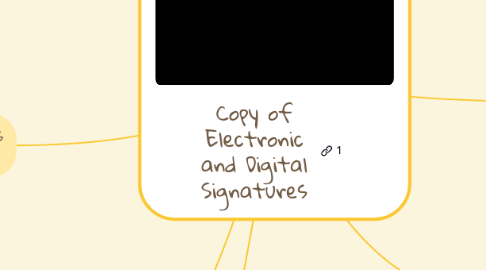Copy of Electronic and Digital Signatures
Siti Sharmila Osminにより

1. Need for Electronic Signatures and Digital Signatures
1.1. Electronic signatures are making life easier for records management leaders, human resources employees and managers in a variety of industries
1.1.1. Protecting the signature at the point of signing.
2. three major legal requirements in Digital Signature
2.1. The signer must be authenticated whenever you do business online, it's important to know who you are doing business with. when it comes to digital signatures, that means using a process called "authentication". signers can prove their identity by confirming their username and password , their day of birth and social security number or even by entering a secret code sent to their cell phone.
2.2. There must be disclosure and consent for a digital signature to be considered legal, you have to prove the signers knew they were signing a legal document. this is done through legal disclosure and consent, which signers must approve before they are able to sign the document.
2.3. The signers must know the signature is legally binding digitally signed documents are just as legally binding as signatures on paper, and it's important that every signer is aware of the legal impact of signing online.
3. implementation of Digital Signatures
4. the use of Digital Signature in an electronic document.
4.1. Digital signature solution providers, such as DocuSign, follow a specific protocol, called PKI. PKI requires the provider to use a mathematical algorithm to generate two long numbers, called keys. one key is public, and one key is private. when a signer electronically signs a document, the signature is created using the signer private key, which is always securely lept by the signer. the mathematical algorithm acts like a cipher, creating data matching the signed document, called a hash, and encrypting that data. the resulting encrypted data is the digital signature. the signature is also marked with the time that the document was signed. if the document changes after signing, the signature is invalidated.
5. Electronic Signatures
5.1. An electronic signature, or e-signature , refers to data in electronic form, which is logically associated with other data in electronic form and which is used by the signatory to sign.[1][2][3] This type of signature provides the same legal standing as a handwritten signature as long as it adheres to the requirements of the specific regulation.
6. Digital Signatures
6.1. A digital signature is a mathematical scheme for demonstrating the authenticity of digital messages or documents. a valid digital signature gives a recipient reason to believe that the message was created by a known sender (authentication), that the sender cannot deny having sent the message (non-repudiation), and that the message was not altered in transit () integrity
7. safety in digital signature and handwritten signatures
7.1. Handwritten signature -Authenticity: may be forged -Integrity: signature independent of the documents -Non repudiation: handwriting expert needed and error prone
7.2. Digital signature -Authenticity: cannot be copied -Integrity: signature depends on the contents of the document -Non-repudiation: can use any computer and error free.



